Ride the Movies
Apply science and engineering practices to design and build an amusement park ride based on a Hollywood film.
My eighth-grade students study science and engineering design through the lens of Hollywood movies. During the semester, they engage in investigations of the science behind events or scenes in films. They design and test catapults and trebuchets such as those used in the Battle at Minas Tirith in The Lord of the Rings: The Return of the King to demonstrate conservation of energy and energy transfer and to determine which device is more accurate and powerful and launches at the greatest distance. They investigate energy transformation by building Rube Goldberg machines inspired by an elaborate jam-jarring scene from Paddington. They research scenes from Disney and Pixar films that depict each of Newton’s laws and engaged in argument from evidence to defend their selections. They create and facilitate interactive lessons to teach their peers about the physics behind the powers of their favorite Marvel and DC superheroes (and villains), including Flash’s speed force and its relationship to the speed formula (s = d/t), the energy transfer and transformation capabilities of Black Panther’s vibranium suit, and Batman’s ability to engineer gadgets to solve specific crime-fighting problems he faces. At the end of the semester, I assess students by having them design, build, and explain the physics behind an amusement park ride based on a Hollywood film.
Prior knowledge and skills
Before this assessment can be assigned, students need to be introduced to the concepts within the big ideas of energy and motion and stability/forces and interactions, and be able to answer questions such as: What is the relationship between energy transfer and transformation and the law of conservation of energy? What are the effects of mechanical energy on the motion of objects? Compare and contrast gravitational, electrical, and magnetic forces. What is the relationship between force interaction and speed, acceleration, and/or velocity of movement? Students should also be able to apply their knowledge of Newton’s laws of motion and gravitation, potential and kinetic energy, and momentum to solve problems in the designed world. Finally, students should be able to use science and engineering practices interdependently to investigate science concepts.
Criteria
At the start of the assessment, students are presented with the following desired outcomes: Complete the assignment on or before the due date, working in class on planning, construction, and evaluation and out of class (as needed) on research and material collection only. Develop a clever way to connect the action or theme of the movie with the action of the ride. Submit (1) a labeled diagram, (2) a written report explaining the science of your ride, including relevant vocabulary terms used appropriately to demonstrate understanding, (3) a video demonstration or explanation of your ride “in action,” and (4) an actual, physical model or prototype of the ride scaled down to a size no smaller than a shoebox and no larger than a large shipping box (18” × 18” × 18”). Create either a working prototype or a physical model of what the ride would look like with signage included.
Students are informed of the necessity for the wearing of safety goggles anytime they were working with projectiles. Students were also given the opportunity to use X-ACTO knives and hot glue guns but only under direct teacher supervision.
Constraints
The following limitations are also presented before construction: Work alone or as a pair; no groups of three or more. Use any materials you wish to build the prototype (available materials from class as well as items you bring in from home). Use any movie (to inspire) or essential question (to guide your research) that we have already studied during our cinema science unit, or you may use any other movie of your choosing as long as discussing it does not violate appropriate classroom norms. Be creative: Don’t copy an existing ride. Rather, engineer an entirely new ride or improve upon an existing ride in a significant way. Don’t recreate something you engineered for a previous design challenge either. Reference information or movie images or names using proper citation.
Next, students are given the Movie Rides Performance Assessment Checklist. This shared document provides scaffolding, support, and guidance for students who struggle with organization and advice for students who are not sure where to start (Figure 1). The checklist helps students organize their work into four categories—research, planning, construction, and communication—and plan their actions according to the steps required within each.
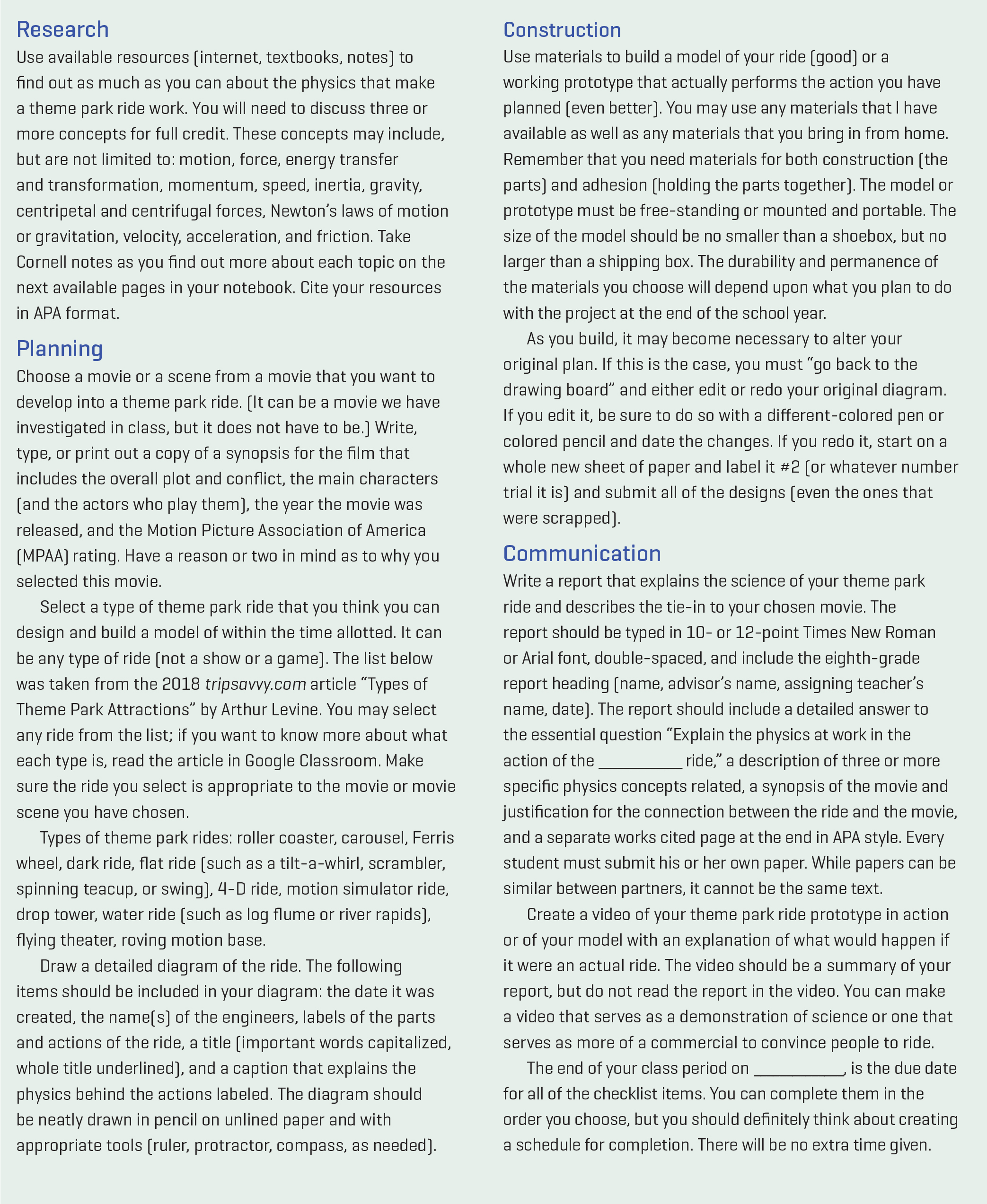
Students work on their projects for 12 class sessions (approximately three weeks). During this time, students conduct research and take notes on physics concepts as well as re-read previous notes taken to gather information for their explanation and report. Students also research different types of theme park rides, as they are encouraged not to make roller coasters because they had already taken on that challenge in another design task. Using the tripsavvy.com article “Types of Theme Park Attractions” (Levine 2018) as a resource, students are surprised to learn that there were many non-roller coaster rides from which they could choose. Suddenly the brainstorming and design planning turns from coasters to dark rides, flat rides, drop-tower rides, and water rides. (For a more detailed timeline, see Figure 2. The checklist given to students is open-ended, allowing them to create their own schedule. The timeline could be used to provide more structure for those students who have difficulty managing their own time.)
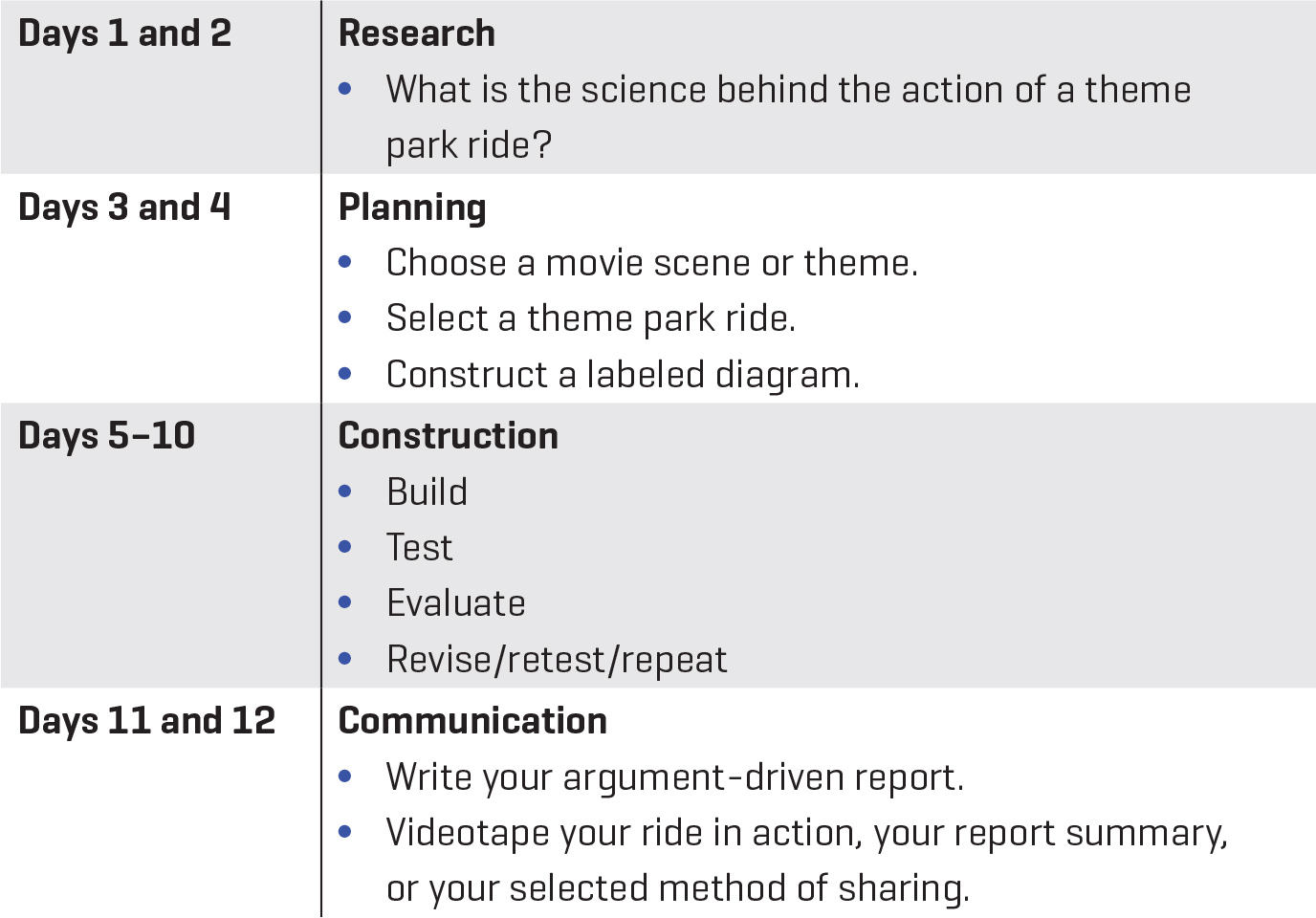
When it comes to construction, students jump right in, having already shown their skills at repurposing recycled materials and objects that were stored in my materials storage closet. Students use everything from craft sticks and modeling clay to building block pieces, cardboard boxes, and aluminum foil. When students can’t find it in the room, they bring it in from home—wooden building blocks, fishing line, balsa wood, dollhouse furniture, and wire hangers. I provided the great majority of materials and resources used. In addition, students who brought materials from home donated them to the “pile” of available resources, making the materials accessible to other groups and classes. One pair of high-flyers designed their model digitally and then printed out a 3-D version using only paper! There was about a 75/25 split between teams who created working prototypes and teams who made visual models. The prototypes are tested, evaluated, revised, and retested multiple times before they are presentation ready. The models also go through a fair amount of revision when they do not look like what the engineers originally envisioned. (Safety checkpoint: Groups that spray paint
In addition to engineering the model itself, students have the opportunity to “show what they know” by writing a report and filming a video of their ride in action. The report explains the physics of their theme park ride and describes the tie-in to their chosen movie. At its core, the report is an argument that responds to the essential question prompt: Explain the physics at work in the action of the _____________ ride. To support the claim, descriptions of three or more specific physics concepts in action are included as evidence, and a synopsis of the movie and justification for the connection between the ride and the movie are included as reasoning.
Physics terms and vocabulary are posted on a classroom wall to give students the support needed to “learn up” (from the student side of the differentiated strategy “teach up”) and use content-specific vocabulary to describe their own understanding of the concepts. This also encourages students’ interdependence as they write their arguments and decreases the number of students who ask me if what they had written was “enough.” Students know it was enough if they address at least three different terms listed.
The video provides further support for the claim by showing the prototype in action or explaining how the ride would work if it was an actual park attraction. The video could be a summary of the report or a more creative representation such as a commercial to convince people to ride. Samples of four students’ reports are included below. (See Figures 3–5 for images of student work.)
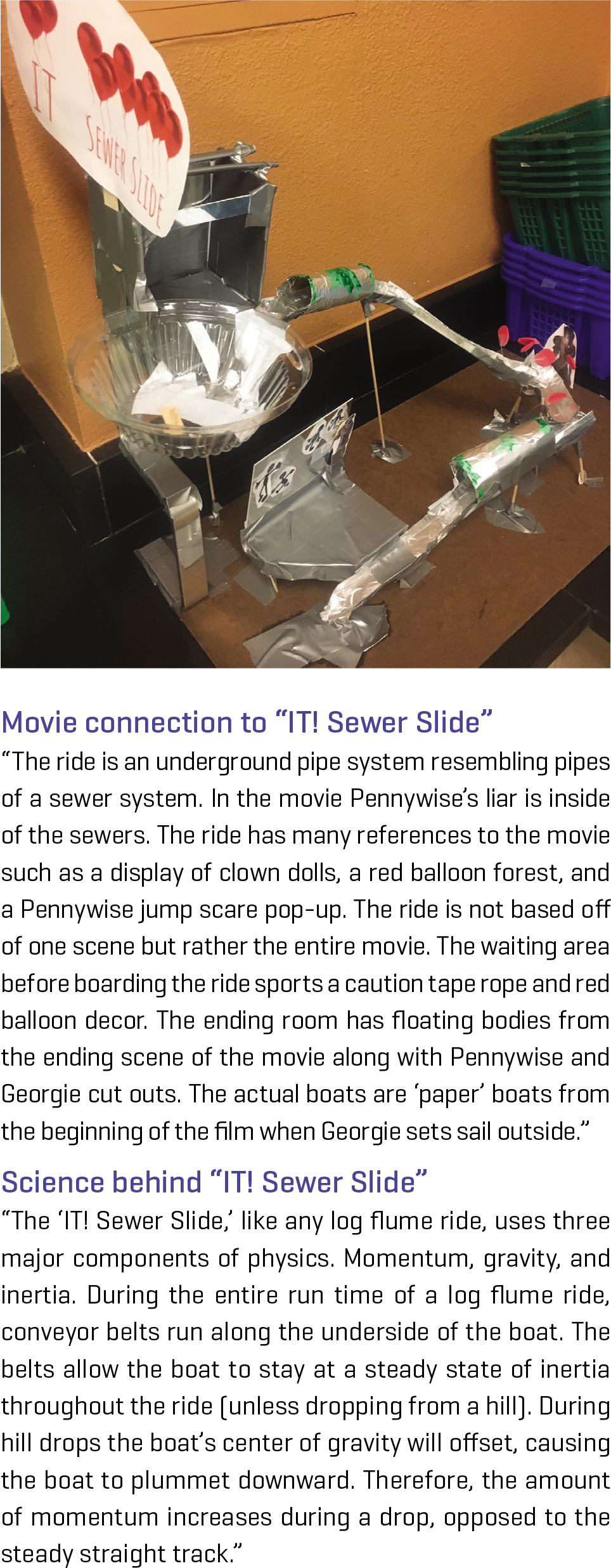
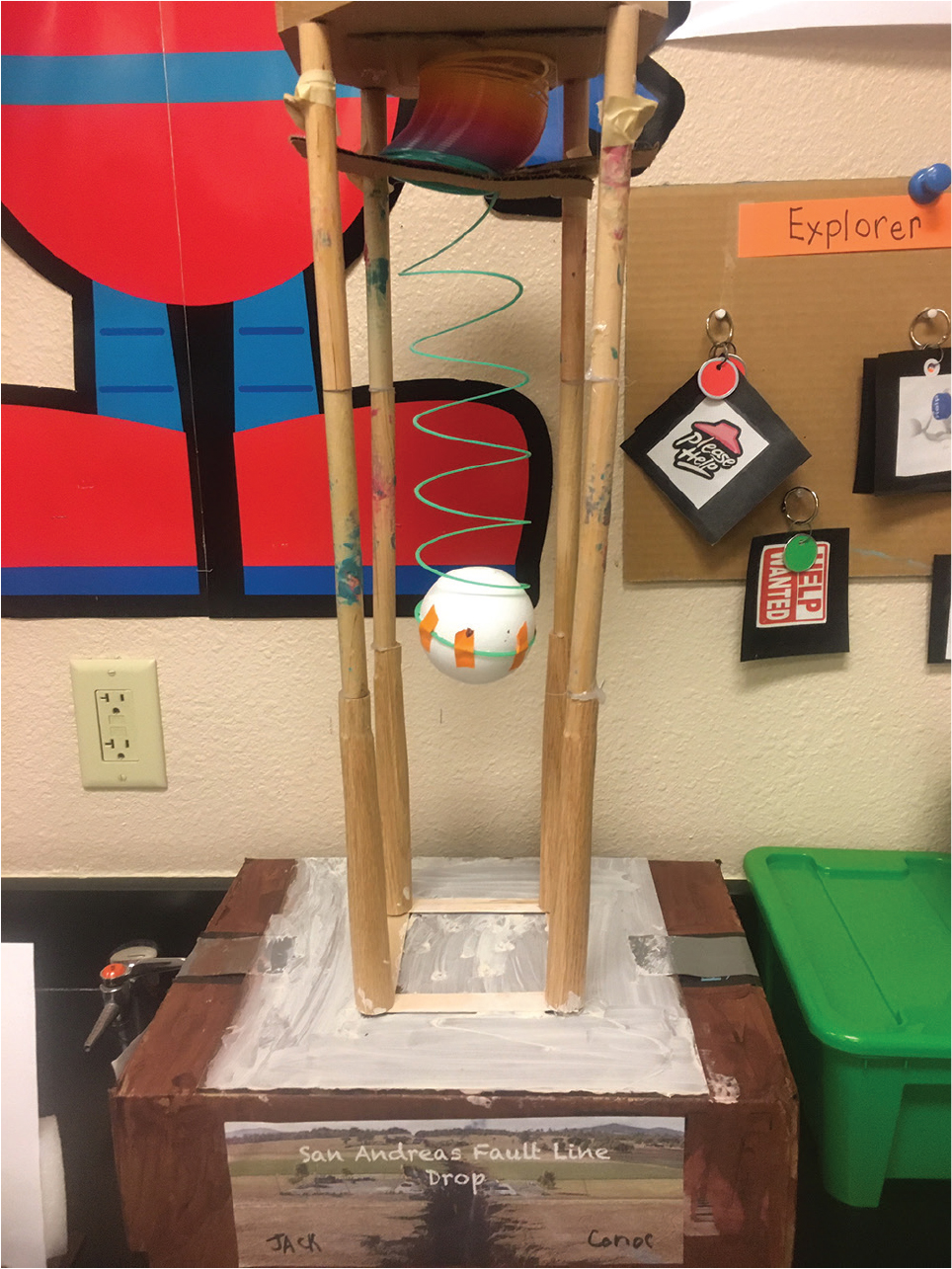
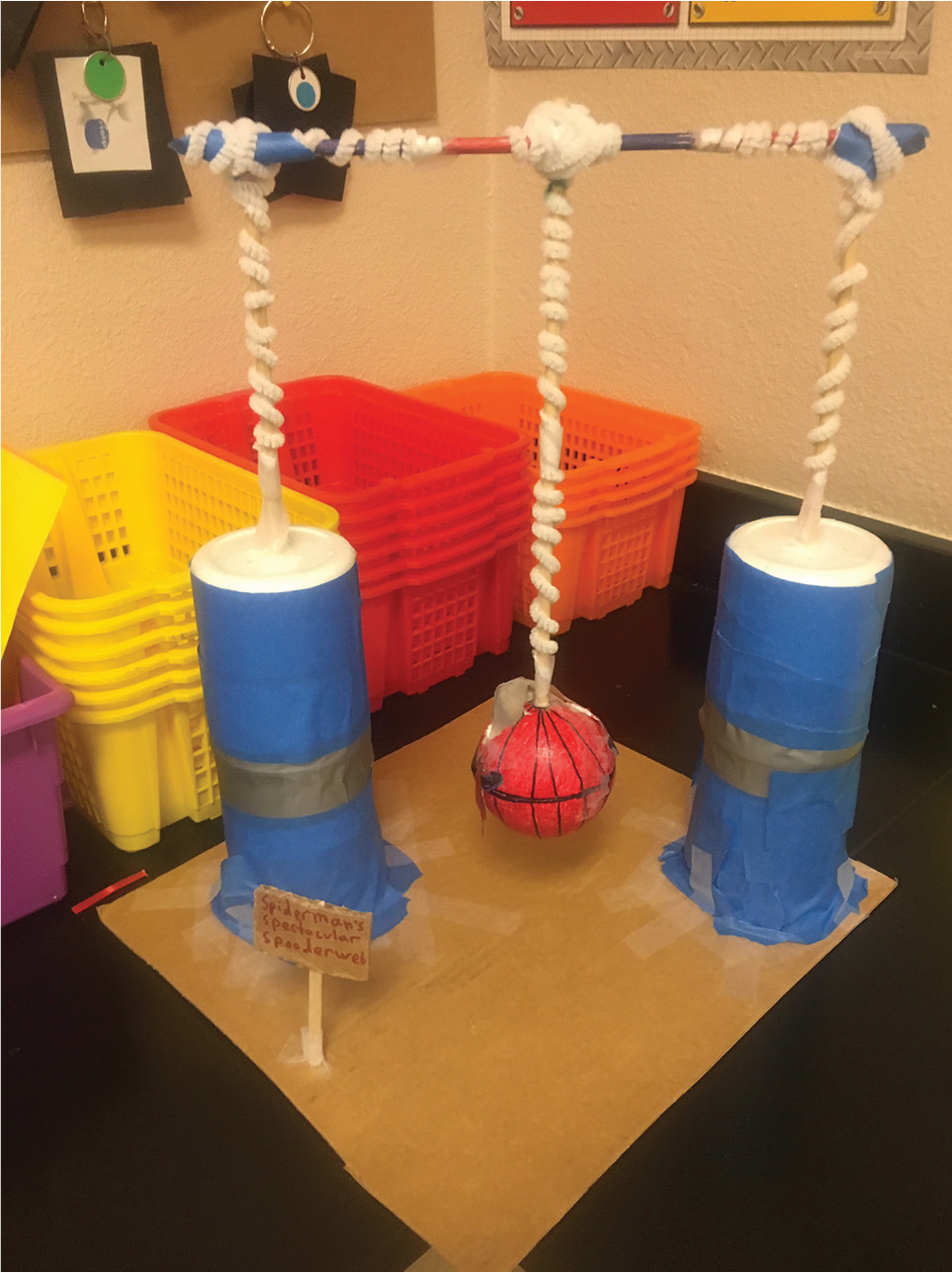
The Movie Rides performance assessment exam provides students with a more authentic reason to investigate answers to questions about physics and a more authentic means with which to demonstrate their knowledge and understanding. Students are able to group themselves by shared interest and learning styles and propose ideas for their own projects, thus maximizing student growth and individual success. Students are provided with a collaborative environment and a performance-based assessment, rather than reading- and writing-based assessment, which are supportive of English language learners and lower-expectancy students. Because students feel ownership in the projects they select, the level of engagement is high throughout both classes in the planning, research, construction, and science aspects. Two or three students were so excited to get to the construction phase that they had to be reminded that construction could not begin until research and planning were completed and approved. A few redirects and a sit-down at the table with these students were all that was needed to manage this issue.
The performance assessment exam is time-consuming compared to a traditional multiple-choice exam (in terms of both administration and evaluation), but the time is well spent given that it leads to a better picture of what students know and are able to do.


